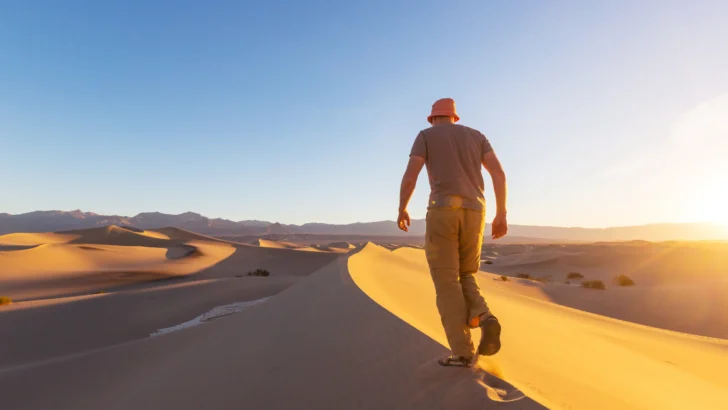As someone who enjoys spending time outdoors, I find hiking and brisk walking to be two of the most popular activities that people engage in. While both of these activities involve walking, there are some key differences between them that are worth noting. In this article, I will explore the differences between hiking and brisk walking, as well as the benefits of each.
Hiking and brisk walking are both great forms of exercise that can help improve your overall health and well-being. However, they are not the same thing. Hiking involves walking on uneven terrain, such as hills, mountains, and trails. It requires more effort and endurance than brisk walking, as you are constantly adjusting to changes in the landscape. Brisk walking, on the other hand, is done on flat, even surfaces, such as sidewalks or paved paths. It is a low-impact activity that can be done at a moderate pace and is less challenging than hiking.

Key Takeaways
- Hiking involves walking on uneven terrain, while brisk walking is done on flat, even surfaces.
- Hiking requires more effort and endurance than brisk walking.
- Both hiking and brisk walking are great forms of exercise that can improve your overall health and well-being.
How Hiking Is Different From Brisk Walking
When it comes to outdoor activities, hiking, and brisk walking are two popular choices. Both activities offer numerous health benefits, but they are quite different from each other. In this section, I will discuss the main differences between hiking and brisk walking.
Terrain
One of the most significant differences between hiking and brisk walking is the terrain. Brisk walking is usually done on flat, smooth surfaces like sidewalks or tracks. Hiking, on the other hand, involves walking on uneven, rocky, and inclined surfaces like hills, mountains, and trails. This makes hiking a more challenging activity that requires more energy and strength.
Intensity
Another difference between hiking and brisk walking is the intensity level. Brisk walking is a low-impact exercise that is suitable for people of all ages and fitness levels. It is done at a moderate pace that raises the heart rate and improves cardiovascular health. Hiking, on the other hand, is a high-intensity exercise that requires more effort and energy. It involves climbing steep hills, crossing streams, and navigating through rough terrain.
Equipment
Hiking and brisk walking require different types of equipment. Brisk walking can be done with comfortable athletic shoes and clothing, while hiking requires specialized gear like hiking boots, backpacks, and trekking poles. The equipment needed for hiking is designed to provide support, traction, and protection from the elements.
Benefits
Both hiking and brisk walking offer numerous health benefits. Brisk walking is an excellent way to improve cardiovascular health, reduce stress, and boost mood. It is a low-impact exercise that is easy on the joints and can be done anywhere. Hiking, on the other hand, offers additional benefits like improved strength, endurance, and balance. It also provides an opportunity to connect with nature and enjoy the outdoors.

In summary, hiking and brisk walking are two different activities that offer unique benefits. Brisk walking is a low-impact exercise that is suitable for people of all ages and fitness levels. Hiking is a high-intensity exercise that requires more energy and strength and provides additional benefits like improved strength, endurance, and balance.
Similarities
When it comes to physical activity, hiking, and brisk walking have many similarities. Here are some of the similarities between these two popular forms of exercise:
Cardiovascular Benefits
Both hiking and brisk walking are excellent forms of cardiovascular exercise. They both increase heart rate and breathing, which can improve lung and heart health. These activities also help to lower blood pressure and reduce the risk of heart disease.
Low-Impact Exercise
Both hiking and brisk walking are low-impact exercises, which means they are easy on the joints. These activities are ideal for people who have joint pain or are recovering from an injury.
Weight Management
Hiking and brisk walking are both effective ways to manage weight. They burn calories and can help to reduce body fat. Regular participation in these activities can lead to weight loss and improved body composition.
Mental Health Benefits
Both hiking and brisk walking have been shown to have mental health benefits. These activities can reduce stress, anxiety, and depression. They can also improve mood and self-esteem.
Accessibility
Both hiking and brisk walking are accessible to most people. They require minimal equipment and can be done almost anywhere. Hiking trails and walking paths can be found in most communities, making it easy to incorporate these activities into daily life.

Overall, hiking and brisk walking have many similarities. They both offer numerous physical and mental health benefits and are accessible to most people.
Differences
When comparing hiking and brisk walking, there are several key differences in terms of terrain, intensity, and equipment.
Terrain
Hiking typically involves more challenging terrain than brisk walking. Hikers often encounter steep inclines, rocky paths, and uneven ground. This can make hiking more physically demanding than brisk walking, as it requires more balance and stability. In contrast, brisk walking is usually done on smooth, flat terrain, which makes it less strenuous and more accessible to people of all fitness levels.
Intensity
Hiking is generally more intense than brisk walking, as it requires more energy and endurance. Hikers often cover longer distances and encounter more challenging terrain, which can increase their heart rate and breathing rate. Brisk walking, on the other hand, is a low-impact activity that can be done at a moderate pace. It is a good option for people who want to get some exercise without pushing themselves too hard.
Equipment
Hiking and brisk walking require different types of equipment. Hikers typically wear sturdy hiking boots, which provide support and traction on uneven terrain. They may also carry a backpack with water, snacks, and other essentials. Brisk walkers, on the other hand, can wear comfortable athletic shoes and carry a water bottle if needed. They do not need to carry as much gear as hikers, as brisk walking is usually done for shorter distances and on smoother terrain.

In summary, hiking and brisk walking are two different activities with distinct differences in terms of terrain, intensity, and equipment. Hiking is generally more challenging and requires more preparation, while brisk walking is a low-impact activity that can be done by people of all fitness levels.
Which Is Better For You
When it comes to deciding between hiking and brisk walking, the answer depends on your personal fitness goals and preferences. Both activities have their benefits and drawbacks. Here are some factors to consider when deciding which is better for you:
Calories Burned
Hiking is generally more intense than brisk walking, which means you’ll burn more calories in less time. However, the exact amount of calories burned depends on several factors, including your weight, speed, and terrain. According to the American Hiking Society, a 150-pound person can burn up to 438 calories per hour hiking uphill, while the same person would burn around 280 calories per hour brisk walking on a flat surface.
Impact on Joints
Brisk walking is a low-impact exercise, which means it puts less stress on your joints than hiking. Hiking, especially on uneven terrain, can be hard on your knees and ankles. If you have joint problems or are recovering from an injury, brisk walking may be a better option for you.
Mental Health Benefits
Both hiking and brisk walking have been shown to have mental health benefits, such as reducing stress and improving mood. However, hiking in nature has been found to have additional benefits, such as reducing symptoms of depression and anxiety. If you’re looking for a mood boost, hiking may be the better choice for you.
Accessibility
Brisk walking can be done almost anywhere, while hiking requires access to trails and natural areas. If you live in an urban area or don’t have easy access to hiking trails, brisk walking may be a more practical option for you.

In conclusion, there is no clear winner when it comes to deciding between hiking and brisk walking. Both activities have their benefits and drawbacks, and the best choice for you depends on your personal preferences and fitness goals.
Hiking Can Be More Challenging Than Brisk Walking, Even If You Are On A Flat Surface
When comparing hiking and brisk walking, it’s important to note that hiking can be more challenging than brisk walking, even if you are on a flat surface. This is because hiking typically involves more rugged terrain, which can require more effort and skill to navigate.
For example, hiking trails may include rocky or uneven terrain, steep inclines, and obstacles such as fallen trees or streams. These challenges can require you to use different muscles and engage your core and balance more than brisk walking on a flat surface.
Additionally, hiking can involve carrying a backpack or other gear, which can add weight and make the hike more challenging. This can also provide a strength-training element to your hike, as you work to carry the extra weight and maintain your balance.
While brisk walking can still provide a great workout and has its own benefits, it’s important to recognize that hiking can offer a more challenging and varied workout experience, even on a flat surface. If you’re looking to switch up your exercise routine and challenge yourself in new ways, consider incorporating hiking into your fitness regimen.
Related Posts:
Different Types Of Terrain That Are Considered Challenging For Hiking
As an avid hiker, I know that not all terrains are created equal. Some trails are a breeze, while others require more effort and skill to navigate. Here are some of the most challenging terrains that hikers may encounter:
Rocky Terrain
Rocky terrain can be tough on your feet and ankles and requires a lot of focus and balance to navigate. It’s important to wear sturdy hiking boots with good ankle support to prevent injuries. Take your time and watch your step, especially on steep inclines or declines.
Steep Inclines
Hiking up a steep incline can be a real challenge, both physically and mentally. It requires a lot of endurance and strength, as well as mental fortitude to keep pushing yourself forward. Take frequent breaks to catch your breath and hydrate, and use trekking poles to help take some of the strain off your legs.
Muddy Trails
Hiking on a muddy trail can be slippery and messy, and requires extra caution to avoid slipping and falling. Wear waterproof hiking boots with good traction, and take your time to carefully navigate the trail. Use trekking poles for extra stability, and consider bringing a change of socks and shoes in case your feet get wet.
Snowy Trails
Hiking on a snowy trail can be a beautiful and rewarding experience, but it also requires extra preparation and caution. Wear waterproof, insulated boots with good traction, and consider using snowshoes or crampons for extra grip. Dress in layers to stay warm, and bring extra food and water in case the hike takes longer than expected.
Desert Terrain
Hiking in a desert can be a unique and challenging experience, with extreme temperatures and minimal shade. It’s important to bring plenty of water and sunscreen and wear lightweight, breathable clothing to stay cool. Watch out for cacti and other desert flora, and be prepared for sudden changes in weather.

In conclusion, hiking on challenging terrain can be a rewarding and exhilarating experience, but it’s important to be prepared and take the necessary precautions to stay safe. With the right gear, mindset, and training, you can conquer any trail that comes your way.
Conclusion
In conclusion, hiking and brisk walking are both great forms of exercise that provide numerous health benefits. While they may seem similar at first glance, there are several key differences between the two activities.
Hiking typically involves more challenging terrain, including steep inclines and uneven surfaces. This makes it a more intense workout that requires greater strength and endurance. In contrast, brisk walking is generally done on flat, smooth surfaces and is a lower-impact form of exercise.
Another key difference between hiking and brisk walking is the equipment required. Hiking often requires specialized gear such as hiking boots, backpacks, and trekking poles, while brisk walking can be done with just a good pair of walking shoes.
When it comes to calorie burn, hiking typically burns more calories than brisk walking due to the increased intensity and use of more muscle groups. However, brisk walking can still be an effective way to improve cardiovascular health and burn calories.
Ultimately, the choice between hiking and brisk walking comes down to personal preference and fitness level. Both activities offer numerous health benefits and can be enjoyable ways to stay active and explore the great outdoors.
Frequently Asked Questions
What are the main differences between hiking and walking at a brisk pace?
Hiking and brisk walking are both great forms of exercise, but they differ in several ways. Hiking typically involves more challenging terrain, such as hills or mountains, and often requires more preparation and gear than brisk walking. Hiking also tends to be more of a full-body workout, engaging not just the legs but also the core and upper body. Brisk walking, on the other hand, is generally done on flat, even terrain and can be a more low-impact form of exercise.
How does hiking compare to running in terms of physical exertion?
Hiking and running are both great forms of cardiovascular exercise, but they differ in terms of intensity. Running is generally a more high-impact form of exercise that puts more stress on the joints, while hiking is generally a lower-impact form of exercise that can be easier on the body. However, hiking can still be a challenging workout, especially if you’re hiking on steep terrain or carrying a heavy backpack.
What are some popular hiking trails near me?
The popularity of hiking varies depending on the location. Some popular hiking trails in the United States include the Appalachian Trail, the Pacific Crest Trail, and the Grand Canyon Rim-to-Rim Trail. To find popular hiking trails near you, try searching online for hiking guides or checking with local outdoor recreation stores or hiking clubs.
Is hiking more beneficial for weight loss than brisk walking?
Both hiking and brisk walking can be effective forms of exercise for weight loss, as they both burn calories and help to improve overall fitness. However, the number of calories burned during a hike or brisk walk will depend on factors such as the intensity of the workout, the length of the hike or walk, and the individual’s weight and fitness level.
What are some key principles of the Leave No Trace policy for hikers?
The Leave No Trace policy is a set of guidelines for minimizing the impact of human activity on the natural environment. Some key principles of the Leave No Trace policy for hikers include packing out all trash and litter, staying on designated trails, minimizing campfire impact, and respecting wildlife and other hikers.
Is hiking primarily a strength or cardio workout?
Hiking can be both a strength and cardio workout, depending on factors such as the terrain and the pace of the hike. Hiking on steep terrain or carrying a heavy backpack can help to build strength in the legs, core, and upper body while hiking at a brisk pace can provide a cardiovascular workout.
